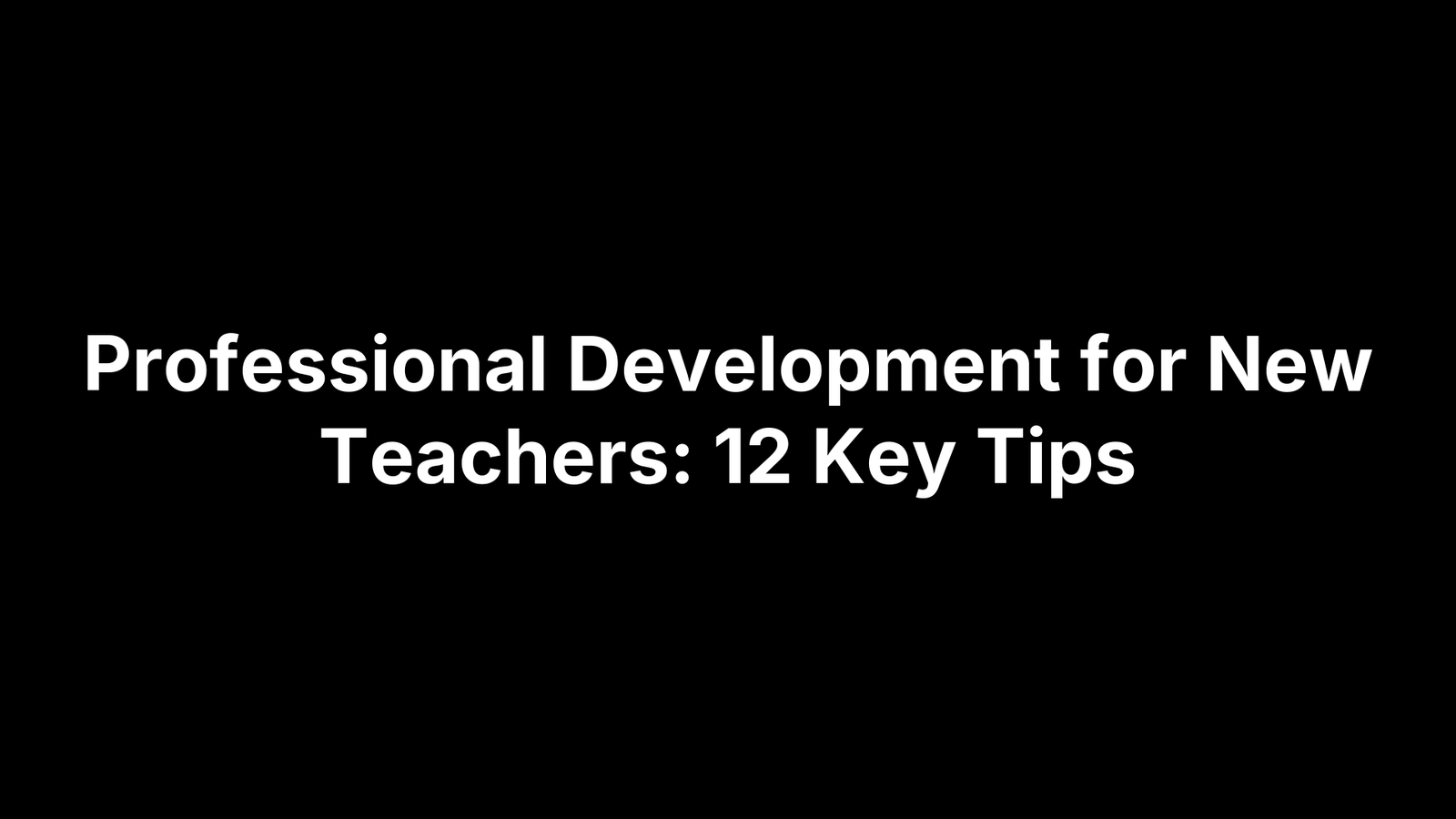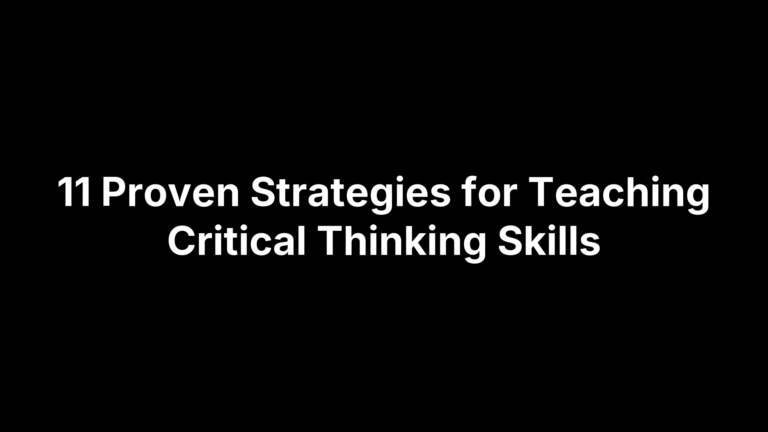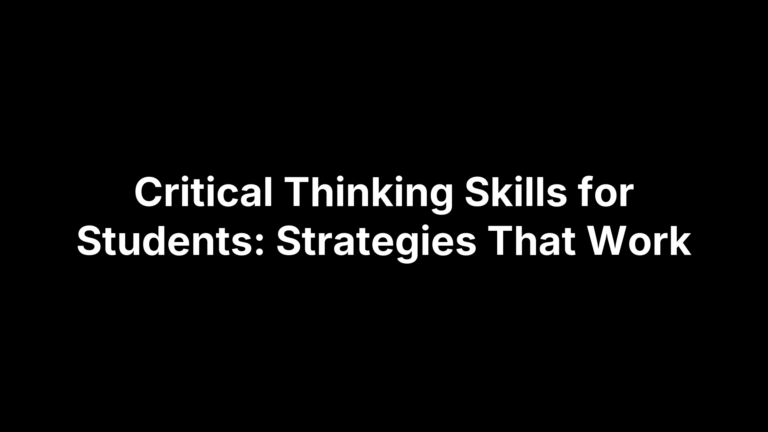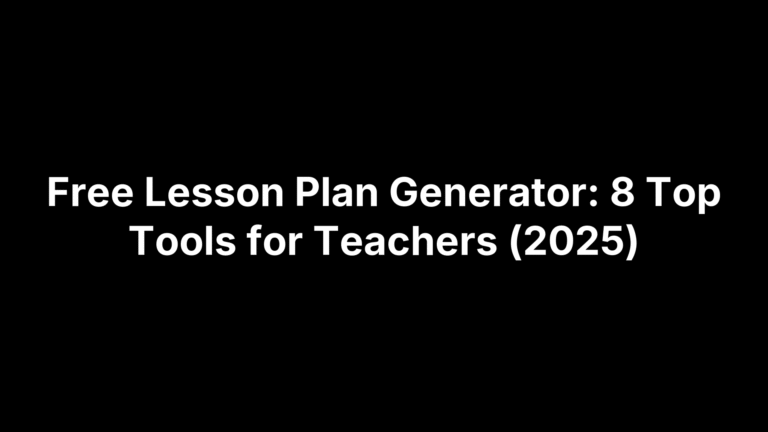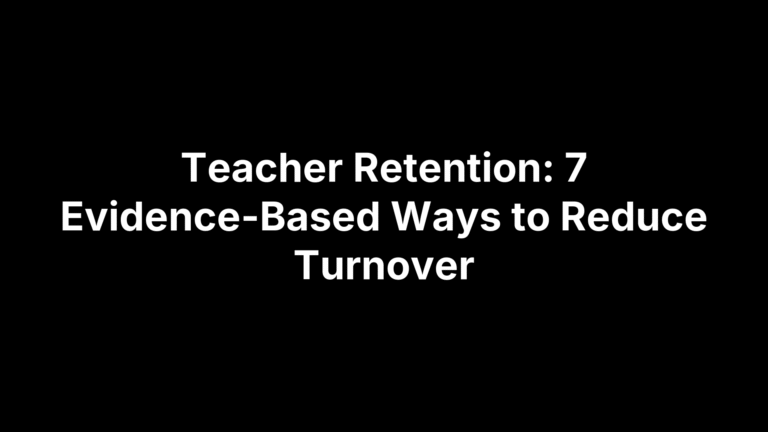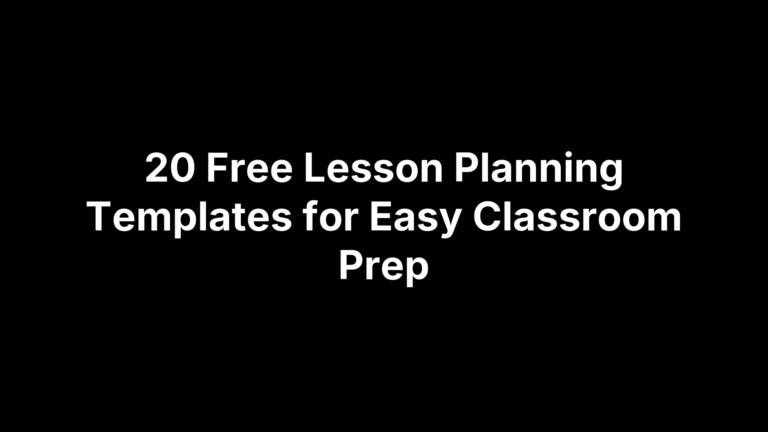12 Key Tips When Seeking Professional Development for New Teachers
If your browser history is filling up with frantic searches for classroom management tricks, affordable workshops, and anything that will make parent-teacher night less nerve-racking, you’re not alone. The first year feels like drinking from a firehose: lessons to prep, students to motivate, data to track, mentors to impress—and somehow you’re expected to build a growth plan before the bell rings.
This guide pares that chaos down to 12 actionable tips that form a clear roadmap toward continuous improvement, student engagement, and fewer grading sessions. Each suggestion blends research-supported practice with free or low-cost resources you can use tomorrow. We start by introducing a one-stop online hub—The Cautiously Optimistic Teacher—and build outward to classroom strategies, mindset shifts, and long-term career moves. Ready to trade overwhelm for progress? Let’s get started.
1. Start With a Go-To Online Resource Hub (e.g., The Cautiously Optimistic Teacher)
Before you chase fifty different blogs, anchor yourself with one dependable hub that curates what matters and tosses the rest.
Why an All-in-One Platform Accelerates Growth
A single log-in means less scrolling and more planning. Consistent terminology across articles, unit plans, and AI tools shortens the leap from “I read it” to “students are doing it”—a game-changer when every prep minute counts.
How to Get the Most Out of The Cautiously Optimistic Teacher
Try this four-step sprint to see ROI in a weekend:
- Create a free account
- Browse blog categories
- Run the AI Worksheet Maker
- Join the weekly PD newsletter
Additional Reputable Hubs to Bookmark
Also bookmark Teaching Channel, NEA Learning Portal, and your state DOE PD page for fresh perspectives.
2. Master Classroom Management and Student Engagement
An organized, student-centered classroom frees you to focus on teaching instead of putting out fires. Nail the basics early and watch behavior issues—and your stress—plummet.
Core Principles: The 7 R’s and Beyond
- Relationships
- Rules
- Routines
- Rights
- Responsibilities
- Respect
- Rewards
Post the R’s, model them, and revisit after breaks. Layer on culturally responsive cues—pronounce names correctly, honor home languages—to make every student feel seen.
Practical Strategies for Day 1 to Day 180
| Minute | Action | Purpose |
|---|---|---|
| 0-1 | Warm greeting at door | Builds rapport |
| 1-3 | Do-Now on projector | Immediate engagement |
| 3-5 | Share objective + agenda | Sets expectations |
Add clear seating charts, silent signals for supplies, and exit tickets that double as formative data.
Evidence-Based Tools and Resources
- PBIS framework for school-wide consistency
- ClassDojo points for instant positive feedback
- Low-tech: call-and-response (“When I say ‘read,’ you say ‘write!’”), proximity, and recorded lessons for self-reflection or mentor coaching.
These methods align with research identifying classroom management as the top PD need for new teachers.
3. Prioritize Social-Emotional Learning (SEL) for Yourself and Students
Long before scores improve, students need to feel safe, heard, and motivated—and so do you. Weaving social-emotional learning into routines steadies behavior, boosts achievement, and gives new teachers a buffer against burnout.
Understanding the Connection Between SEL and Academic Success
A 2023 CASEL meta-analysis linked explicit SEL instruction to an 11-percentile jump in academics and sizable drops in disciplinary referrals. For teachers, practicing the same self-regulation skills cut stress indicators by nearly one-third—proof that SEL fuels both sides of the desk.
Integrating SEL Routines Into Daily Lessons
Micro-moments work: one-minute breathing, feelings polls, or restorative circles weave SEL into content without derailing pacing.
| Day | Quick SEL Focus |
|---|---|
| Mon | Gratitude sticky note |
| Wed | 3-min guided mindfulness |
| Fri | Goal-setting reflection |
Recommended SEL PD Modules and Certificates
Level up with free CASEL webinars, state DOE micro-credentials, or Panorama Education’s on-demand modules—each issues printable badges you can drop into your PD portfolio before evaluation season.
4. Implement Data-Driven Instruction From the Start
Numbers aren’t the enemy; they’re breadcrumbs showing where students thrive or get stuck. Building a data habit is budget-friendly professional development for new teachers, helping you pivot instruction and reteach less.
Collecting and Interpreting Formative Assessment Data
Keep it simple: an exit ticket, a three-question Google Form, or a fist-to-five self-rating reveals more than a unit exam delivered too late. Log results in a color-coded spreadsheet linked to standards so patterns pop.
Differentiating Instruction Using Results
Red scores? Pull that cluster for a mini-lesson while others tackle an extension task. Amber students get scaffolded question stems; green students create practice problems—a built-in enrichment loop.
Tech Tools That Simplify Data Analysis
Edulastic auto-tags questions to standards, Formative graphs mastery over time, and The Cautiously Optimistic Teacher’s Question Generator builds leveled checks in seconds.
5. Join or Build a Professional Learning Community (PLC)
No rookie thrives alone. A Professional Learning Community hands you built-in coaches, idea swaps, accountability, and momentum—minus the price tag of formal PD subscriptions.
Finding PLC Opportunities (In-School, District, Online)
Start local: grade-level or department teams meet weekly to analyze student work. District cohorts run semester cycles. Online, pop into #ntchat on X, ISTE Community forums, or a private Facebook group for your content area.
Setting SMART Goals and Norms for Effective Collaboration
Agree on a specific, measurable target—“Increase persuasive-essay scores 10% by February.” Assign roles (facilitator, timekeeper, note-taker) and stick to 45-minute, agenda-driven meetings.
Leveraging Virtual PLC Platforms
Google Classroom, Microsoft Teams, or Slack keep agendas, resources, and reflections in one searchable thread—perfect for asynchronous feedback when schedules clash.
6. Seek Mentorship and Peer Coaching
Mentorship turns theory into lived practice faster than any webinar. A veteran’s quick tip after watching your lesson can shave weeks off the trial-and-error cycle that defines professional development for new teachers.
Identifying the Right Mentor Match
Look for someone who teaches your subject or shares your pedagogical vibe, has time for regular check-ins, and views coaching as dialogue, not rescue.
Structuring Observations and Feedback Loops
Start with a pre-conference to set a pinpoint goal, e.g., tighter transitions. During the observation, the mentor tallies evidence; afterwards, co-craft a single next step.
Making the Relationship Mutually Beneficial
Offer reverse mentoring—share your tech hacks or fresh curriculum ideas—so the relationship stays reciprocal. Trade resources and co-present at PLC meetings to spotlight joint growth.
7. Explore Micro-Credentials and Online Courses
When time and money are tight, stackable micro-credentials and bite-size online courses keep professional development for new teachers flexible and goal-oriented. The key is choosing certificates that directly improve the skills your evaluation rubric measures.
Selecting Courses Aligned With Your Instructional Needs
- Cross-check course outcomes with the Danielson domains or district look-fors.
- Prioritize skills you can implement next week—e.g., Google Certified Educator for formative tech or EdTechTeacher badges on project-based learning.
Budget-Friendly (or Free) Options for New Teachers
- Audit Coursera and edX classes at no cost.
- Claim state DOE free-PD days and webinars.
- Post a DonorsChoose PD request; many districts approve it within days.
Tracking and Showcasing Your Learning
Maintain a living PD portfolio in Google Sites or OneNote: upload certificates, jot 100-word reflections, and link evidence (student work, assessment gains) to prove impact during evaluations.
8. Develop a Personalized Professional Growth Plan (PGP)
A Professional Growth Plan (PGP) turns wishful thinking into an evidence-based map for advancement in your first teaching year.
Setting Measurable Goals Tied to Standards
State goals like: “I will boost Danielson 3b scores 15% by Dec 15 using exit-ticket data.” Concrete metrics prevent drift and align with PGP guidance from state certification boards.
Designing an Action Plan and Timeline
Chunk the journey into 30-60-90-day sprints, then list discrete actions and resources for each window.
| Day Window | Key Action | Resource |
|---|---|---|
| 0-30 | Observe mentor twice; collect baseline discourse data | District rubric |
| 31-60 | Implement Socratic seminars weekly | Teaching Channel videos |
| 61-90 | Video-record lesson, self-score, share with PLC | Phone camera + rubric |
Collecting Evidence of Impact
Archive artifacts—student discussion transcripts, rubric scores, and lesson recordings—in your PD portfolio to prove growth during evaluation conferences.
9. Embrace Culturally Responsive and Inclusive Teaching
Seeing student culture as an instructional asset boosts engagement and evaluation scores, making culturally responsive practice a core strand of professional development for new teachers.
Core Concepts: Culture, Identity, and Bias
Culturally responsive teaching pivots on three ideas:
- Culture shapes cognition—background knowledge frames how students process content.
- Identity is fluid—allow learners to bring their full, evolving selves into class work.
- Bias is inevitable—catch it early with quick reflections: Who speaks most? Whose examples dominate slides?
Designing Inclusive Curriculum and Classroom Spaces
Rotate paired memoirs, primary sources, and local voices; offer flexible seating or standing options; and embed Universal Design for Learning checkpoints so every student can access, practice, and show learning in multiple ways.
PD Resources to Deepen Cultural Competence
Level up with Teaching Tolerance’s free webinars, educator nights at local cultural centers, or a #DisruptTexts virtual book club you launch with your PLC.
10. Integrate Educational Technology With Purpose
Technology can amplify strong instruction—or simply add noise. Treat every app, device, or AI tool as a means to a pedagogical end, never the end itself. Purposeful integration saves time, improves feedback loops, and becomes built-in professional development for new teachers.
Choosing Tools Based on Pedagogical Goals (SAMR/TPACK)
Use the SAMR ladder or TPACK Venn to sanity-check choices: if a tool doesn’t at least Augment learning or strengthen the Pedagogy–Content–Tech overlap, skip it. Sketch a quick flowchart: Need collaboration? → Choose Jamboard; Need retrieval practice? → Pick Quizizz.
Starting Small: Low-Barrier EdTech Wins
- Interactive slides with Pear Deck for live checks
- Padlet exit tickets that auto-archive reflections
- Screencastify mini-lessons students replay on demand
Each requires under ten minutes of setup yet yields actionable data.
Ongoing Training to Keep Skills Current
Block a monthly “sandbox” period to test one new feature, lurk in #edtech Twitter chats, and skim vendor webinars while grading. Small, steady bites keep your toolkit—and confidence—fresh.
11. Protect Your Well-Being Through Intentional Self-Care
Midnight lesson tweaks and inbox pings drain energy fast. For professional development for new teachers to stick, your nervous system must be online—self-care is essential pedagogy.
Recognizing Signs of Burnout Early
- Sunday dread showing up on Friday
- Snapping at students over minor issues
- Decision fatigue by third period
Practical Self-Care Routines for Busy Teachers
- Insert 5-minute box breathing between classes
- Batch grade twice a week, not nightly
- Declare one tech-free evening
- Commute with mindfulness, not lesson planning
Schools and PD Programs That Support Wellness
- Request wellness stipends for gym or apps
- Join lunchtime staff yoga streams
- Earn Educator Resilience micro-credit PD
12. Attend Workshops, Conferences, and EdCamps
When you can swap lesson ideas face-to-face with hundreds of educators, growth accelerates. Live events—whether a district workshop or an unscripted EdCamp—supply fresh strategies, vendor demos, and morale that can’t be streamed.
Deciding Which Events Provide the Best ROI
Prioritize gatherings that check these boxes:
- Align to a current goal on your PGP
- Offer sessions in your grade/content area
- Include hands-on labs or classroom simulations
- Provide digital archives so you can replay later
- Fit your travel budget or grant funding
Networking Strategies to Maximize Learning
Use the 3-2-1 rule:
- Meet 3 new colleagues
- Capture 2 actionable ideas
- Schedule 1 follow-up chat within a week
Snap badge pics, tweet key quotes, and tag presenters—you’ll grow an instant PLC.
Translating Conference Takeaways Into Classroom Practice
| Idea | Action by Friday |
|---|---|
| Student podcasting demo | Record a 2-minute sample episode with Period 3 |
| Visible thinking routines | Add “See-Think-Wonder” to Monday’s bell ringer |
| AI feedback tool | Pilot on one writing assignment, collect student reactions |
Share your table at the next PLC to keep momentum high.
Moving Forward With Confidence
Sustainable professional growth is more like interval training than a sprint: intense bursts of learning, followed by reflection and refinement. Treat these 12 tips as checkpoints. Every quarter—perhaps at report-card time—open your planner, reread each section, and note one small victory and one next step. That rhythm keeps the momentum rolling long after the first-year adrenaline fades.
When you’re ready for your next burst, swing by The Cautiously Optimistic Teacher for fresh articles, AI tools, and community conversations that extend the professional development for new teachers outlined here. While you’re there, pop your email into the newsletter form; a five-minute Friday read can spark the idea that powers Monday’s lesson. You’ve got this—keep learning forward.
